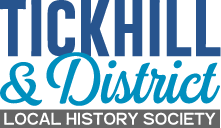

Local dialects
In the 1950s the University of Leeds carried out a national survey of dialects. Tickhill was selected as one of the 34 places in Yorkshire to be surveyed and five men here were interviewed in 1951. Albert Cooper (b.1877), Thomas Ludlam (b.1897), Alfred Saxton (b.1880), Herbert Smith (b.1872) and Charles Edward Whinfrey (b.1882) had all left the local school at age 12 or 13. Cooper was a retired miner then farmer, Ludlam a farmer, his family having worked the same farm for 300 years, Saxton a retired carrier, Smith a painter then farm labourer, and Whinfrey a retired builders’ labourer.
They were asked to name a variety of farm animals, crops and farm buildings, for example. Their answers were then transcribed using a phonetic alphabet and ultimately published so that both the vocabulary and pronunciation in response to each question could be compared with the responses of other Yorkshire and northern counties’ participants.
Here are some examples of the vocabulary the five men used: a pigsty was called a pig-cote, a hay-loft was a foderum, a fork prong was a grain, potatoes were taties, a basket was a skep. As part of a dialect and heritage project, the University of Leeds plans to interview descendants of those who took part in 1951.
For more details see the website: <[email protected]>
For part of a recording of one of the five men (unidentified) see: <https://sounds.bl.uk/Accents-and-dialects/Survey-of-English-dialects> then put Tickhill in the search box. Joan Saxton believes it could be Thomas Ludlam being interviewed.
Another project is a Yorkshire Historic Dictionary of dialect words, drawn from documents dating from the 12th to the 18th centuries, in memory of Professor David Hey and Dr George Redmonds. The Borthwick Institute for Archives and Yorkshire Archaeological and Historical Society Record Series have produced an online version of the dictionary which includes place names, agricultural terms, landscape descriptions and specialist craft and industrial terms (such as brewis, gimmer, smoot and spiking). More information is available at the following website: <york.ac.uk/borthwick/projects/yorkshire-dictionary>